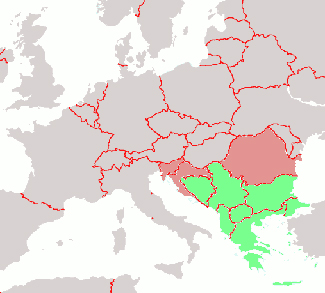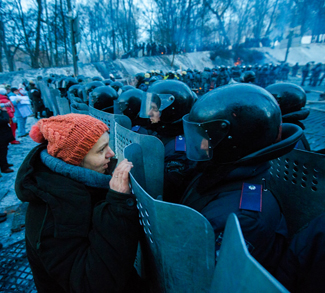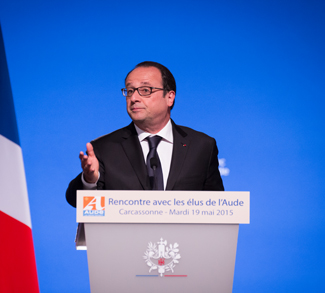Simmering geopolitical environments in Middle East (ME), characterised by violence and conflicts have posed a challenge as well as a threat to the security, peace and stability of Western Balkan Region (WBR). The EU woke up to a surprise when a wave of instability swept across ME and authoritarian governments, considered strong and stable thus far, fell like a pack of cards (Arab Spring). “The Middle East is the most important geography which can directly affect the EU’s well-being in economic and security aspects. Weak governance, if not absolute corruption, the absence of rule of law and justice, nepotism and non-adherence to the democratic processes were the main collapse-syndromes that many see as possible recurring phenomenon in Western Balkan if these were allowed to pass by in the ME without inferring clues to achieve peace and prosperity in WBR.
WBR, the periphery of Europe, or as some call it ‘the periphery of the periphery,’ is vital ground that Europe cannot remain oblivious about. Though it poses no military threat of any significant magnitude, it has the potential to become a conduit for various threats and challenges emanating from the Middle East and Sahel-Sahara Region. These threats are as follows:
Illegal Immigrant Traffic
Involves the act of recruiting, transporting, transferring, harbouring or receiving a person using force, coercion or other means, for the ultimate purpose of exploitation. Every year, thousands of men, women and children fall into the hands of traffickers, in their own countries and abroad. Every country in the world is affected by trafficking, whether as a country of origin, transit or a destination for victims [1]. In the wake of visa liberalisation for the WBR by the EU, immigrants have tended to leave the poorer areas of the WBR in order to seek better living conditions within the EU and richer WBR states. This trend is historic and perhaps manageable by the WBR or at least not as risky as the inflow of Asians and Africans who beat the Border Check Points (BCP) ability to interdict illegal immigrants. Such illegal immigrants may be criminals, potential terrorists or arms and drug smugglers as no record of their credentials is available as compared to those falling in the category of regular immigrants. The WBR would certainly be impacted, as the statistics prove, as an increasing number of them are appearing on Greece-Turkish, Romania-Serbian and Serbian-Macedonian borders. Out of total 7400 detections of irregular traffic in 2011, on the basis of nationality, Afghans had a 28 % share, followed by 25% being Pakistanis. This increase resulted from the combination of increasing flows and more efforts undertaken by the Serbian authorities to detect migrants at their green borders. Consequently, Serbia’s 2011 share in the region’s overall total for illegal border-crossing rose to a massive 40%, up from just 3% in 2010 [2]. Yet there appear to be some deterring arrangements in place that keep WBR somewhat immune from the machinations of the organized crime axis. Therefore, the criminals who facilitate the illegal immigrants from Africa and the ME, by employing modes worse than those meted to animals, have not been able to develop WBR as huge market so far. It still revolves around $ 150 million as compared to illegal immigrants from East, West and North Africa to Europe and from Latin America to North America that fetched them a bonanza of about $ 6.75 billion last year. UNODC plays a crucial role to train and build the target state’s capacity to combat organised crime. The EU in concert with UNODC appears to be mindful of this aspect and the vulnerability that confronts the WBR.
Drug Trafficking
Western Europe is a lucrative market for drug traffickers. The annual flow of drugs through global markets weighs in at about 450 tons. Out of this, 2008 statistics show that 380 tons of heroin and morphine were produced in Afghanistan alone, gaining access to Western Europe and Russia through Pakistan, Iran, Turkey, Greece, Bulgaria and the WBR (the western approach) as well as through the Caspian and Central Asia (the northern approach). There have been sizeable seizures also, conspicuously in Turkey and Iran but the drug barons appear determined to swallow these losses for the sake of the Western European market ($ 20 billion) and the Russian Federation market ($13 billion) [3]. Along the route, some quantities are sold to locals that are wreaking havoc on the societies where one finds large numbers of young addicts without any hope of recovery. To put it simply, when the drug route of the western approach from Afghanistan is fairly broad, it converges on the WBR. This stands as an understandable concern for WBR governments. They are left with no choice but to accept the challenge to eliminate drug trafficking through operational as well as pre-emptive strategies in concert with EU. In other words, the EU is compelled to consider that its stakes are high in the WBR. Covering the threat of huge quantities of cocaine from Colombia is not a direct concern here because no significant source is located in the ME. However Europe shares a big brunt. In 2008, 470 tons of cocaine moved to North America, Canada and Europe and while 40 % was consumed in North America only, a quarter of it ended up reaching Europe.
Terrorism
Terrorists invariably have a political agenda that is often ambitious. They enjoy universal alliance, though unspoken, with all such elements in any part of the world across all conceivable divides because their mutual interests do not clash. In other words, at least their sympathisers if not abetters are found everywhere. Such vulnerability haunts the WBR because conventionally drugs, illegal human trafficking, arms smuggling and terrorists are traditional allies that move hand in glove and trace a common trajectory. In the WBR, ordinary crimes have declined but organised crime has remained indelible. The corruption and crime nexus could not be refuted, particularly when ethnic wars were rampant. In case of Bosnia-Herzegovinian, there has been support from Middle East militants though no conclusive evidence has come forth, not necessarily because it did not exist but for the possibility that these groups may have managed clandestine support effectively.
Money Laundering
Organized crimes perpetrators need to funnel money to give it legitimacy or stash it at such locations and banks so that their wealth remains out of sight. Bojan Dordevic contends that money laundering involves disguising the source of illicit profits and is achieved through a basic process (although money laundering typologies differ in complexity)
Placement – illicit proceeds are placed within the formal banking secor.
Layering – illicit proceeds are redistributed through a series of accounts in small amounts so as to disguise the origin of the funds; and
Integration – the once-illicit proceeds are now licit and are used to purchase property, stocks and bonds so that they can be deposited legally into client bank accounts [4].
To afford the states the desired ability to nab these ill-gotten treasures, UNODC has been assigned the role to enforce laws to combat money laundering and terror financing in shape of Global Programmes against them, employing its unit that was established in 1997. The unit mandate was reinforced by subsequent protocols and legal instruments to enable the states for implementing necessary measures to combat the curse of money laundering. The unit also provides guidance and technical assistance. WBR certainly deserves to seek help from UNODC.
Global Overview of Tangential Threats to EU
The destiny of Balkans, and more importantly of the WBR, is intertwined with the destiny of Europe. Therefore any conflict scenario looming on the horizon worldwide, threatening Europe would be a dire challenge for the Balkans as well. As the globalisation is characterised by the universal interconnectivity through rapid communication means hence long stretch of spaces have shrunk. The EU thrust in European as well as adjoining continents is not only to manage the conflicts but to resolve them despite not possessing any integral military might except within the NATO Charter. The conflict issues in ME, Caucasus, Korean peninsula, Indian Subcontinent and recently in Asia-Pacific can wreck EU efforts to quell eruptions in and around Europe as well as in far flung areas to the East. For instance, in all cases, if diplomacy fails and conflict graph probability picks up; US, India, Japan, Australia, Israel, Pakistan, Russia, China, Vietnam, Philippines, Malaysia, North and South Korea, Egypt, Iran and Turkey are likely to be sucked in by any of the imbroglios one way or the other. An EU that maintains ideal relations with large spread of countries would be the first casualty by way of resultant traction on Euro-Atlantic alliance directly and on trade volumes indirectly that would tailspin because future conflicts would also be riddled with economic blockades and severing of sea lanes. The point to emphasise here is not to give the probable dimensions of each conflict but to elucidate a point that the EU has on its responsibility card, not only the European continent and the ME but the stretch of spaces that could become a war arena anywhere in the world. What really emerges from the prevailing strategic and global military orientation is that EU has to be forthcoming to conduct a dispassionate critique of its own erring allies as well as others when the friendly and not so friendly powers are suspected to embrace too much of Richelieu Concept and show scant regard for the urge to sustain peace. It also implicitly means that world’s greater expectations for conflicts resolution would seek a major shift from the traditional titans to would-be honest brokers. EU is in unique position to adjust to these emerging global realities.




